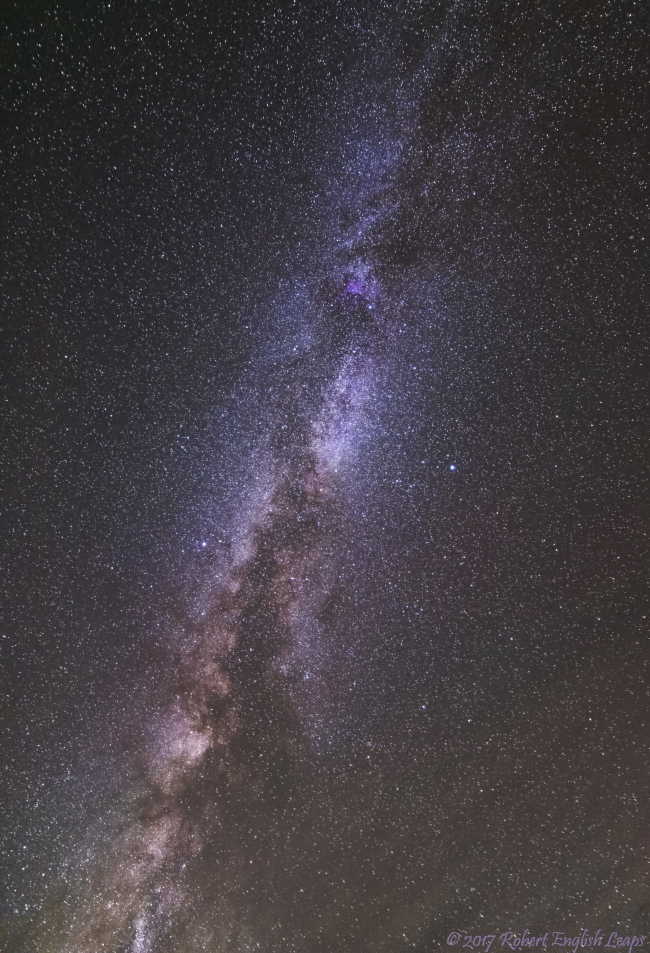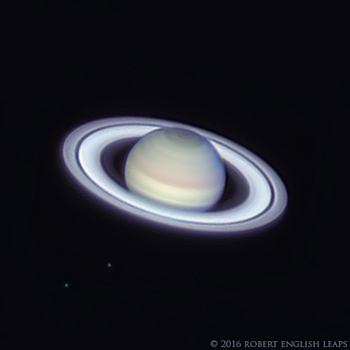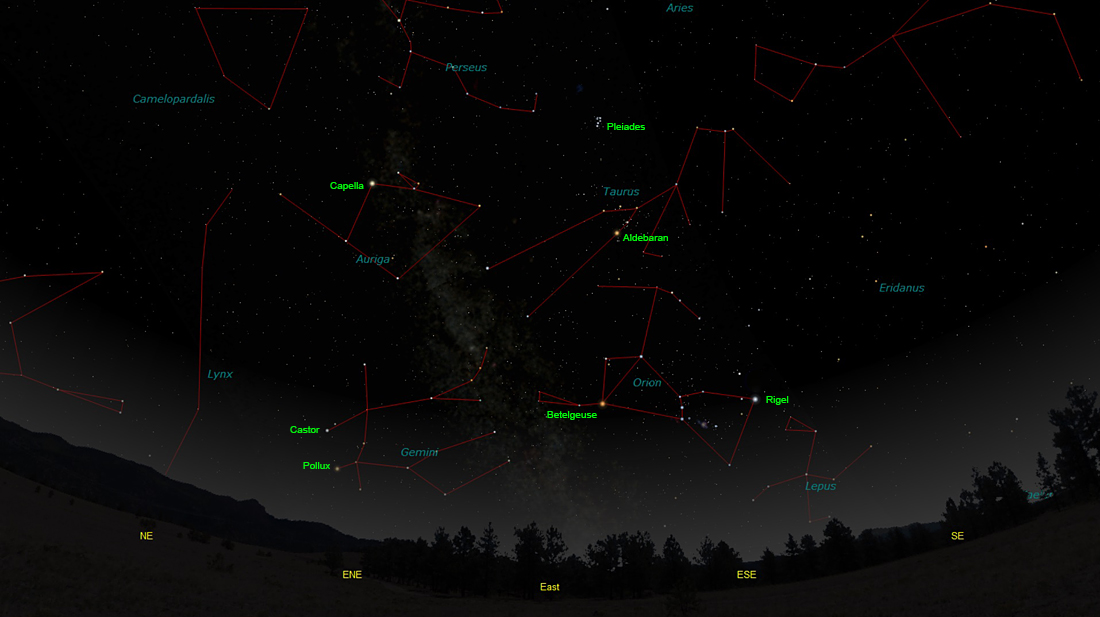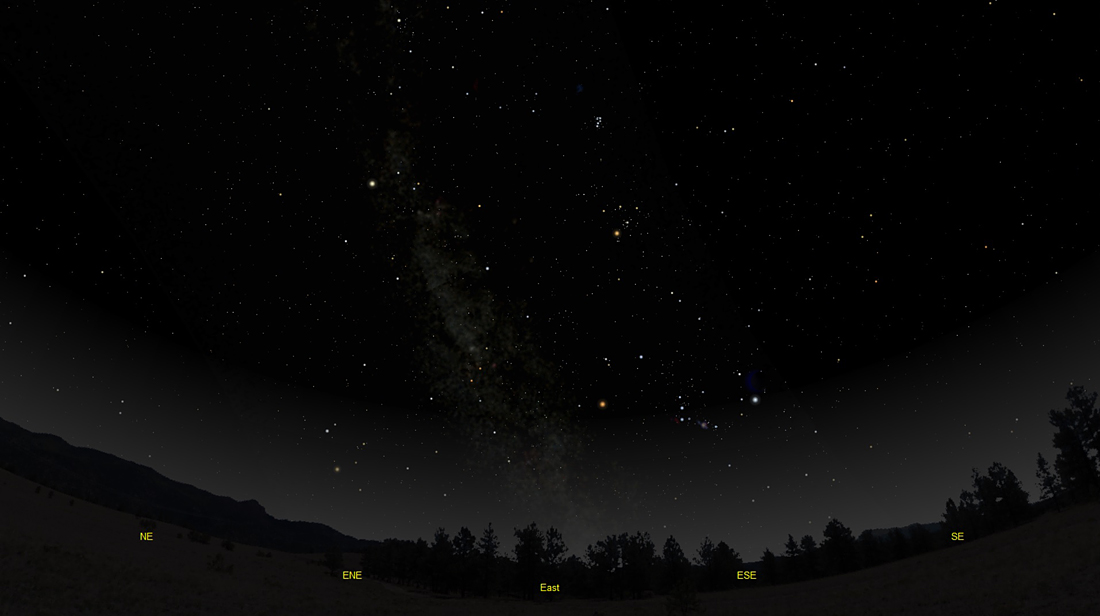The purpose of this feature is to give scout leaders, educators and naturalists an idea of some of the natural events coming up each month. We will try to cover a variety of natural events ranging from sky events to calling periods of amphibians, bird and mammal watching tips, prominent wildflowers and anything else that comes to mind. We will also note prominent constellations appearing over the eastern horizon at mid-evening each month for our area for those who would like to learn the constellations. If you have suggestions for other types of natural information you would like to see added to this calendar, let us know! Note: You can click on the hyperlinks to learn more about some of the featured items. To return to the Calendar, hit the "back" button on your browser, NOT the "back" button on the web page. All charts are available in a "printer friendly" mode, with black stars on a white background. Left clicking on each chart will take you to a printable black and white image. Please note that images on these pages are meant to be displayed at 100%. If your browser zooms into a higher magnification than that, the images may lose quality. Though we link book references to nationwide sources, we encourage you to support your local book store whenever possible.
Notes and Images From October 2017
Even with this schedule the hike was spectacular. There were many scenic vistas as we made our way up the mountain, and when the stars came out the views were worth all of the effort. The image at right is a single 25-second exposure from a fixed tripod. It spans a large swath of the Milky Way. To give a sense of scale, you can hover your mouse over the image and the Summer Triangle (Vega, Deneb and Altair) is labeled. The image does not include the brightest parts of the Milky Way in southern Sagittarius. When we look at the Milky Way we see older golden stars at the core of our galaxy and the younger blue stars in the spiral arms. Compare the colors and dark dust patterns in the image above to the image of the edge-on spiral galaxy NGC 4565 here. The air at Death Valley is incredibly clear. At bottom right in the image, notice the faint colored bands extending diagonally upward. This is air glow. Air glow is a phenomenon of the upper atmosphere. Atoms that were ionized by the Sun's radiation during the daytime recombine during the evening hours and emit light during this process. The result is faint bands of greens, reds and blues that extend across the sky. They are most visible about 15 degrees from the horizon.
One of the most remarkable things about the mountain habitat was the virtual absence of sound on the way back down the mountain. We found ourselves savoring the silence.
These caterpillars do not have prolegs like many other caterpillars in other families. Instead they have suckers on their abdomens and even produce a kind of liquified silk to provide lubrication and help them move. Often their overall shape is flattened, and many bristle with stinging hairs which can be painful if they brush against your hand. To me they often look like little alien landing crafts, and the variety of shapes and colors in the family is amazing. I can only recall seeing one member of the family previously, the Saddleback Caterpillar. The Crowned Slug Caterpillar favors oak, cherry, maple, basswood, elm and beech leaves when foraging. The hairs along its periphery and down its back will sting on contact. Larvae overwinter in loose oval cocoons and emerge as adult moths in the spring. Sky Events for November 2017: The Leonid Meteor Shower peaks on the morning of November 16th. Best viewing is in the early morning hours. The moon will be absent during the peak, resulting in dark skies. Evening Sky:
Saturn is visible all month, but view it as early as possible in the evening to get the best telescopic views. Look for it in the southwest in Ophiuchus. The rings are now open to their maximum tilt of 27 degrees. M ercury is visible low in the southwestern sky about 30 minutes after sunset beginning around November 17th. It reaches greatest elongation from the Sun on November 23rd.Uranus and Neptune are both visible in binoculars this month if you are patient and take the time to look for them. We spotted both recently from urban skies in 10x30 binoculars. Finder charts for both are here. If you have an app like Sky Safari (see "Recommended" below) it makes the hunt a lot easier.
Morning Sky: Look for bright Venus low in the eastern sky before sunrise. Venus and Jupiter appear to pass each other in the dawn sky on November 13th. On that date you can see both planets in the same medium power telescope field of view.Mars will be above Venus in the morning sky this month, in Virgo. In the telescope it appears quite small, less than 4 arc-seconds in apparent diameter.Constellations: The views below show the sky looking east at 9:30pm CST on November 15th. The first view shows the sky with the constellations outlined and names depicted. Star and planet names are in green. Constellation names are in blue. The second view shows the same scene without labels.Auriga , the Charioteer, with its bright star Capella is prominent in the northeast. Look for the bright stars Castor and Pollux as the constellation Gemini, The Twins, clears the horizon. In the southeast, mighty Orion clears the horizon with its bright stars Betelgeuse and Rigel. Note the difference in color between the two stars. Betelgeuse is a red giant and looks orange. Rigel is a very hot supergiant and looks bluish. Looking at the center of the three "sword" stars with binoculars, you can see M42, the Orion Nebula. Just poking its head above the horizon is Lepus, The Hare.On Learning the Constellations: We advise learning a few constellations each month, and then following them through the seasons. Once you associate a particular constellation coming over the eastern horizon at a certain time of year, you may start thinking about it like an old friend, looking forward to its arrival each season. The stars in the evening scene above, for instance, will always be in the same place relative to the horizon at the same time and date each November. Of course, the planets do move slowly through the constellations, but with practice you will learn to identify them from their appearance. In particular, learn the brightest stars for they will guide you to the fainter stars. Once you can locate the more prominent constellations, you can "branch out" to other constellations around them. It may take you a little while to get a sense of scale, to translate what you see on the computer screen or what you see on the page of a book to what you see in the sky. Look for patterns, like the stars that make up Orion.The Earth's rotation causes the constellations to appear to move across the sky just as the Sun and the Moon appear to do. If you go outside earlier than the time shown on the charts, the constellations will be closer to the eastern horizon. If you observe later, they will have climbed higher. As each season progresses, the Earth's motion around the Sun causes the constellations to appear a little farther towards the west each night for any given time of night. If you want to see where the constellations in the above figures will be on December 15th at 9:30pm CST, you can stay up till 11:30pm CST on November 15th and get a preview. The westward motion of the constellations is equivalent to two hours per month. Recommended: Sky & Telescope's Pocket Star Atlas is beautiful, compact star atlas. A good book to learn the constellations is Patterns in the Sky, by Hewitt-White. For skywatching tips, an inexpensive good guide is Secrets of Stargazing, by Becky Ramotowski.
A good general reference book on astronomy is the Peterson
Field Guide,
A Field Guide to the Stars and Planets, by Pasachoff. The book retails for around $14.00.
The Virtual Moon Atlas is a terrific way to learn the surface features of the Moon. And it's free software. You can download the Virtual Moon Atlas here. Cartes du Ciel (described in the monthly notes above) is a great program for finding your way around the sky. It is also free, and can be downloaded here. Apps: We really love the Sky Safari 5 Pro. It is available for both iOS and Android operating systems. There are three versions. The Pro is simply the best astronomy app we've ever seen. The description of the Pro version reads, "includes over 27 million stars, 740,000 galaxies down to 18th magnitude, and 620,000 solar system objects; including every comet and asteroid ever discovered." For upcoming events, the Sky Week application is quite nice. Available for both I-phone and Android operating systems.A nother great app is the Photographer's Ephemeris. Great for finding sunrise, moonrise, sunset and moonset times and the precise place on the horizon that the event will occur. Invaluable not only for planning photographs, but also nice to plan an outing to watch the full moon rise. Available for both androids and iOS.
Amphibians:
We think of November as the quietest time of year for Tennessee frogs and toads. However, some song can still occasionally be heard. Listen for Spring Peepers, Upland Chorus Frogs and Southern Leopard Frogs. Checking around ponds at night with a flashlight held next to your temple will often show the eye shine of Southern Leopard Frogs, Green Frogs and Bullfrogs. As in October, you can locate many of the frogs and toads that have been calling more frequently earlier in the year by driving the back roads slowly on rainy nights. This is a two person job. One person watches the road for amphibians and one person looks out for other vehicles.
Recommended:
The Frogs and Toads of North America,
Lang Elliott, Houghton Mifflin Co. Archives (Remember to use the back button on your browser, NOT the back button on the web page!)
Natural Calendar February 2016 Natural Calendar December 2015 Natural Calendar November 2015 Natural Calendar November 2014 Natural Calendar September 2014 Natural Calendar September 2013 Natural Calendar December 2012 Natural Calendar November 2012 Natural Calendar September 2012 Natural Calendar February 2012 Natural Calendar December 2011 Natural Calendar November 2011 Natural Calendar September 2011 Natural Calendar December 2010 Natural Calendar November 2010 Natural Calendar September 2010 Natural Calendar February 2010 Natural Calendar December 2009 Natural Calendar November 2009 Natural Calendar September 2009 Natural Calendar February 2009 Natural Calendar December 2008 Natural Calendar November 2008 Natural Calendar September 2008 Natural Calendar February 2008 Natural Calendar December 2007 Natural Calendar November 2007 Natural Calendar September 2007 Natural Calendar February 2007 Natural Calendar December 2006 Natural Calendar November 2006 Natural Calendar September 2006 Natural Calendar February 2006
Natural Calendar December 2005
Natural Calendar November 2005
Natural Calendar September 2005
Natural Calendar February 2005
Natural Calendar December 2004
Natural Calendar November 2004
Natural Calendar September 2004
Natural Calendar February 2004
Natural Calendar December 2003
Natural Calendar November 2003 Natural Calendar February 2003 Natural Calendar December 2002 Natural Calendar November 2002 Nature Notes Archives: Nature Notes was a page we published in 2001 and 2002 containing our observations about everything from the northern lights display of November 2001 to frog and salamander egg masses. Night scenes prepared with The Sky Professional from Software Bisque All images and recordings © 2016 Leaps.
|
|






